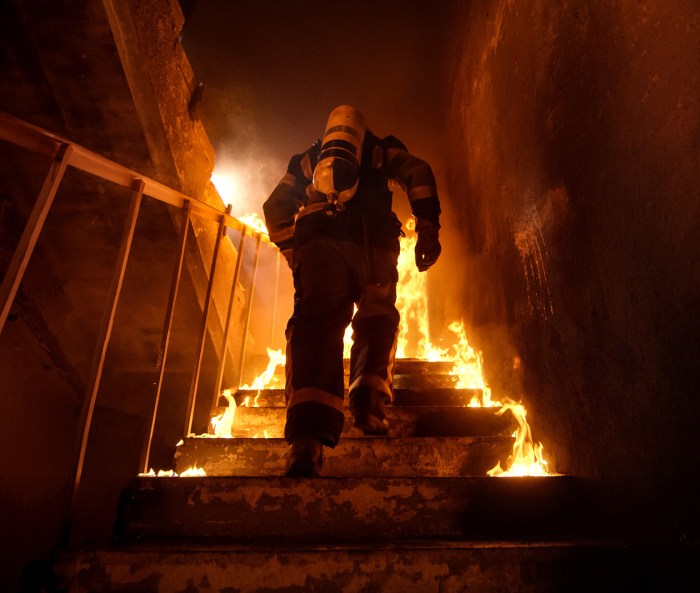Structural firefighting strategy and tactics are fundamental pillars in the realm of fire suppression, guiding firefighters in their mission to extinguish blazes and protect lives. This article delves into the intricate world of structural firefighting, exploring the strategies, tactics, and essential considerations that shape this critical discipline.
From understanding fire behavior and building construction to employing firefighting equipment and adhering to safety protocols, structural firefighting demands a comprehensive approach. This article unravels the complexities of this specialized field, providing insights into the strategies and tactics that enable firefighters to combat fires effectively and ensure the safety of both occupants and responders.
Structural Firefighting Strategy: Structural Firefighting Strategy And Tactics

Structural firefighting strategy is the overall plan of action for fighting fires in buildings and other structures. It is designed to protect life, property, and the environment, and to minimize the damage caused by fire.
There are three main types of structural firefighting strategies: offensive, defensive, and transitional.
Offensive Strategy
- The offensive strategy is used when the fire is small and confined, and there is a good chance of extinguishing it quickly.
- The goal of the offensive strategy is to attack the fire directly and extinguish it as quickly as possible.
Defensive Strategy
- The defensive strategy is used when the fire is large and out of control, or when there is a danger of the fire spreading to other structures.
- The goal of the defensive strategy is to protect life and property, and to prevent the fire from spreading.
Transitional Strategy
- The transitional strategy is used when the fire is in between the offensive and defensive stages.
- The goal of the transitional strategy is to transition from the offensive strategy to the defensive strategy, or vice versa, as the situation dictates.
The selection of a particular structural firefighting strategy depends on a number of factors, including the size and location of the fire, the type of building construction, the availability of resources, and the weather conditions.
Structural Firefighting Tactics

Structural firefighting tactics are the specific actions that firefighters take to implement the structural firefighting strategy.
There are a number of common structural firefighting tactics, including:
Hose Streams
- Hose streams are used to extinguish fires by applying water or other extinguishing agents directly to the fire.
- Hose streams can be used in a variety of ways, including:
- Direct attack: Applying water or extinguishing agents directly to the fire.
- Indirect attack: Applying water or extinguishing agents to the area around the fire to cool the fire and prevent it from spreading.
- Overhaul: Applying water or extinguishing agents to the burned area to extinguish any remaining embers.
Ventilation
- Ventilation is the process of removing smoke and heat from a building.
- Ventilation is important for a number of reasons, including:
- To improve visibility for firefighters.
- To reduce the temperature of the building.
- To remove toxic gases from the building.
Forcible Entry
- Forcible entry is the process of gaining access to a building or other structure that is locked or otherwise inaccessible.
- Forcible entry may be necessary for a number of reasons, including:
- To rescue occupants.
- To fight the fire.
- To ventilate the building.
The principles of tactical decision-making in structural firefighting include:
- Size-up:Assessing the situation and identifying the hazards.
- Plan:Developing a plan of action.
- Execute:Carrying out the plan of action.
- Evaluate:Evaluating the effectiveness of the plan of action and making adjustments as necessary.
Fire Behavior and Structural Firefighting
Fire behavior is the way that fire spreads and develops.
Fire behavior is influenced by a number of factors, including:
- The type of fuel.
- The amount of fuel.
- The oxygen supply.
- The temperature.
- The wind.
Fire behavior can have a significant impact on structural firefighting operations.
For example, a fire that is burning in a compartment can be relatively easy to extinguish, while a fire that is running through a building can be much more difficult to control.
Firefighters must be aware of the different types of fire behavior and how they can impact firefighting operations.
Types of Fire Behavior
- Compartment fires:Fires that are confined to a single room or compartment.
- Running fires:Fires that are spreading through a building.
- Flashovers:Fires that occur when a large amount of combustible material is heated to its ignition temperature.
Firefighters must be able to recognize the different types of fire behavior and take appropriate action to extinguish the fire.
Building Construction and Structural Firefighting

Building construction has a significant impact on structural firefighting operations.
The type of building construction can affect the way that fire spreads, the amount of heat and smoke that is produced, and the ease of access for firefighters.
For example, a building that is constructed of wood is more likely to burn quickly and produce a lot of smoke than a building that is constructed of concrete.
Firefighters must be aware of the different types of building construction and how they can affect firefighting operations.
Types of Building Construction, Structural firefighting strategy and tactics
- Wood-frame construction:Buildings that are constructed of wood.
- Steel-frame construction:Buildings that are constructed of steel.
- Concrete construction:Buildings that are constructed of concrete.
Firefighters must be able to identify the different types of building construction and take appropriate action to extinguish the fire.
Common Queries
What are the primary strategies employed in structural firefighting?
Structural firefighting strategies encompass offensive, defensive, and transitional approaches, each tailored to specific fire conditions and objectives.
How do firefighters determine the most appropriate strategy for a given fire?
Factors influencing strategy selection include fire size, location, building construction, and available resources.
What are some common structural firefighting tactics?
Examples of structural firefighting tactics include hose streams, ventilation, forcible entry, and search and rescue operations.